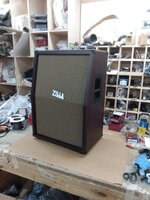Also. How hard is it to change speakers?
I have changed speakers a lot. I have a great system now. But when you are new, if you don't understand the wiring methods, then the simplest way is to
1. Take a picture at the beginning. Also put tape at each connection on the wiring, and mark it as top right, top center..etc.
2. either unclip or unsolder the speaker connections. Like Dan said, most have the quick connects. That would be easiest.
3. Taking out the speakers is the easiest part, but remember gravity is a motherfucker, so if you do it with cab flat on the floor, you may drop your screwdriver into a speaker cone and fuck the whole process. I do it with the cabinet in a vertical position on a workbench.
4. when installing the new speakers, you may use an impact to quicken the process, however, you need to have a skilled trigger finger. I will use the impact on my mills because it has studs only to close the distance to the speaker. I do not tighten the speaker with the gun. i do that by hand.
The speaker is not going to fly into outer space. There is a pad on the front of the fucker because all you need to do is secure the speaker to the cab inasmuch as the speaker cannot move freely. It does not need to be torqued to shit. Overtightening can bend the rim. Also, you can use the lugnut diagonal method which is to say, tighten one screw/nut then go for the furthest screw/nut away to tighten. What i do is just hand tighten, then give a quarter turn with a nut driver or socketwrench. You may also add a dab of silicone to keep it from backing out. This is a pretty good practice with a nut/stud arrangement.
Optionally, you can test each speaker with a 9volt battery to make sure they are all in phase and not wired backwards and/or you can wire the whole thing together and check the phase by putting the tip and ring to open two conductor wire and taping the other side of the two conductors to the 9 volt battery, then holding the tip or ring and just bouncing the other side while you look at each speaker to make sure it "jumps" in correct direction.
I also hook up a speaker cable and test the ohms with my multimeter just to make sure eveything is going right. on 8 ohm cab, you can sometimes get a reading like 6. On a 16 ohm cab, you can sometimes get a reading like 12 or 13. This is not a big deal. But you don't want to get a reading of around 4 on a 16 ohm cab.

